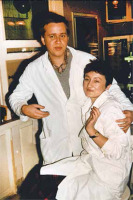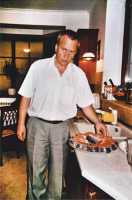Sławomir Majewski was born in 1956 in Kielce. In 1981, he graduated from the Faculty of Medicine of the Medical University of Warsaw. From 1981 to 1984 he worked at the Department of Histology and Embryology, Institute of Biostructure, where he did and defended his doctoral thesis entitled “Factors influencing blood vessel formation: in vivo and in situ studies”.
After his PhD he started to work at the Department of Dermatology in Warsaw under the guidance of Professor Stefania Jablonska. This resulted in gaining excellent medical skills and experience in conducting research in the field of experimental and clinical dermatology reflected by numerous scientific publications. In 1984, Sławomir Majewski established and directed the Laboratory of Cellular Skin Immunology, which quickly became a breeding ground for young scientific talents. He defended his habilitation thesis entitled “Vascular changes and immunological disturbances in scleroderma – their interconnections” in 1988. At the same time he obtained specialization in dermatology and venereology, and in 1997 – in allergology. He received the title of Professor of medical sciences in 1993.
From 1998 to 2005, he was the Director of the Institute of Venereology in Warsaw and then the Head of the Department of Dermatology and Venereology, established on the basis of the new structure of the Institute. He was highly valued by his colleagues, because while holding the position of the Head of the Clinic for many years he became known not only as a good organizer, but also as a direct person with great empathy, always ready to help with his ability to solve problems and, moreover, able to identify the most important needs of employees.
From 1996 to 2010 he served as the Deputy Chairman of Division VI of Medical Sciences of the Polish Academy of Sciences (PAN) and of the European Medical Research Councils (EMRC). In 2002 he was appointed a corresponding member of the PAN.
From 2008 to 2016 he served as the Vice-Dean for Science and International Cooperation of the Medical University of Warsaw and the Head of the Centre for Preclinical Research and Technology (CEPT) of the Medical University of Warsaw.
Professor Majewski was an active member of many international scientific societies such as the European Academy of Dermatology and Venereology, European Association for Cancer Research, American Association for Cancer Research, International Advisory Committee of the Archives of Dermatology, International Editorial Committee of the Journal of American Academy of Dermatology. From 2000 to 2004 he served as a member of the Board of the European Society of Dermatological Research.
Professor Sławomir Majewski’s scientific output is impressive – he was an author or co-author of over 400 articles published in scientific journals of the highest prestige, i.e. New England Journal of Medicine, The Lancet, Immunology Today, Journal of National Cancer Institute, Cancer Research, International Journal of Cancer, Journal of Investigative Dermatology, Journal of Immunology, Journal of Virology, Journal of Infectious Diseases, American Journal of Pathology, Leukemia, Arthritis and Rheumatism, Journal of American Academy of Dermatology, Archives of Dermatology, British Journal of Dermatology, and British Journal of Cancer. His publications have been cited more than a thousand times.
Professor Majewski was a manager or coordinator of projects financed by European funds, including the “Copernicus” grant, EPIDERM (European Initiative for Prevention of Dermatological Malignancies), ECRIN (European Clinical Research Infrastructure Network) project and EHR4CR (Electronic Health Records for Clinical Research) project within IMI (Innovative Medicines Initiative).
He was an excellent academic teacher and educator of young doctors and scientists. His ability to cooperate with young scientists resulted in the promotion of 25 PhD theses and several specializations in dermatology and venereology. Training young people was Professor Majewski’s real passion since he was one of the founders and the first chairman of the Forum Młodych – a section of the Polish Society of Dermatology, gathering young scientists, active in the field of experimental and clinical dermatology. Many members of the Forum Młodych are now internationally recognized dermatologists.
In the first stage of his scientific career, Professor Majewski’s main area of interest was immunodermatology, especially pathogenesis of scleroderma, and mechanisms of cutaneous oncogenesis, especially the role of human papilloma viruses (HPV) and mechanisms of tumour angiogenesis. Later (2002–2008) he worked in the team of the International Steering Committee in the FUTURE II Research on the first vaccine against human papillomavirus (HPV).
The high international scientific position of Sławomir Majewski was a result of cooperation with scientists from the best dermatological and scientific centres in the world, where he not only gained outstanding knowledge, but also made friends and maintained long-term scientific contacts. This cooperation was initiated by two annual prestigious scientific scholarships in Germany and France. In 1989–1990, he received a Humboldt Scholarship and stayed at the Department of Dermatology and the Institute of Immunology at the University of Munich, working with Professor Thomas Krieg (former Head of the Department of Dermatology at the University of Cologne). During his one-year stay in Germany he also established cooperation with Professors Agatha and Thomas Schwarz from the Department of Dermatology at the Westphalian Wilhelms University in Muenster. From 1990 to 1991 he worked as a visiting professor at the Unite des Papillomavirus at the Pasteur Institute in Paris (CNRS fellowship) with Prof. Gerard Orth.
The cooperation initiated in the early 1990s was fruitfully continued to the end, and Polish young scientists, students of Sławomir Majewski, had and still have the opportunity to improve their skills in the best scientific centres.
Memories of international cooperation
Thomas Krieg (Professor at the University of Cologne and past Chairman of the Department of Dermatology, University of Cologne): Slawek joined our research group for one year in 1990, shortly before we moved to Cologne. He was an enthusiastic scientist full of curiosity and a lively discussant, at that time concentrating on demonstrating gene expression in the skin by in situ hybridization and applying the then novel RT-PCR technology. We all miss him (Figures 1, 2).
Figure 1
Slawek, Beate Eckes visiting Agatha and Thomas Schwarz in Vienna, celebrating science and friendship
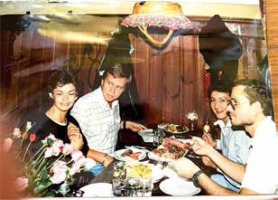
Figure 2
With fond memories of our very en-joyable and fruitful collaboration in Munich. Here a snapshot of Nico Hunzelmann handing over our farewell present with Bavarian good-ies to Slawek before he started on his trip back to Warsaw with his car, loaded with Christmas presents for his family
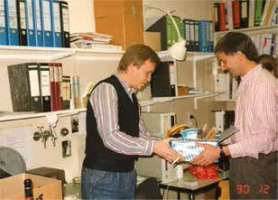
Agatha Schwarz (Biologist, Head of the Laboratory of Cell Biology at the Department of Dermatology at the Christian-Albrechts-University Kiel). Our research interest focuses on the regulation of inflammatory reactions in the skin and in particular the role of regulatory T cells in these processes. Slawek and I were extremely interested in the role of regulatory T cells in psoriasis and other autoimmune diseases. We discussed very often the therapeutic possibility for the new treatments and I have tried to establish scientific models to prove those hypotheses. Slawek and I shared our interest in studying epidermodysplasia verruciformis (EV) as a model for a defective immune system. We started our cooperation in 1988 in Vienna and continued our studies also thereafter in Munster and in Kiel. Slawek had collected many paraffin blocks of skin biopsies from EV patients and one of his PhD students was working for almost one year in my lab. We observed that the skin of EV patients overexpresses antimicrobial peptides. This might be the reason why the wounds of these patients heal rather quickly despite the immune deficit. During my brief stay in Munich where Slawek worked as a scholar for one year he taught me the secrets of in situ hybridization, a rather new and exciting technique in those days. We had a wonderful time together and found new friends among the scientists working in Prof. Thomas Krieg’s lab. I will miss him not only as a scientific partner but even more importantly as a wonderful person and a close friend (Figures 3–6).
Figure 3
Slawek, Nico Hunzelmann (right), Agatha and Thomas Schwarz having dinner in the apartment of Agatha and Thomas
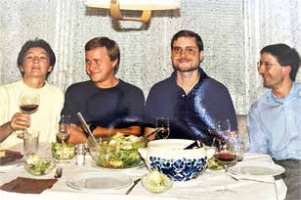
Figure 4
Slawek and Martin Röcken (University of Tübingen) visiting Agatha and Thomas Schwarz in their apartment in Munster. Scientific discussion with self-made pumpkin “Cesar”. Material and Methods: Thomas Schwarz
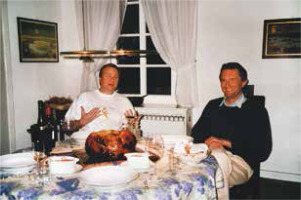
Thomas Schwarz (Chairman of the Department of Dermatology, Christian-Albrechts-University Kiel): “Slawek and I shared our interests in photoimmunology. Slawek was interested in the impact of ultraviolet radiation (UV) on the promotion of HPV-mediated carcinogenesis, in particular epidermodysplasia verruciformis, and I was and still am interested in the role of regulatory T cells in UV-induced immunosuppression. Although we both never had a direct cooperation, we even do not share a single publication, we were in constant scientific interchange in numerous conversations on the occasion of personal visits or at meetings. The discussion with Slawek was always a pleasure and I am sure this contributed to a scientific cross-fertilization of both of us. I will miss him not only as a scientific partner but even more importantly as a wonderful person and friend.”
Gerard Orth (honorary professor at the Pasteur Institute in Paris): As part of the research program undertaken with Professor Jablonska since 1976, I had a close and very fruitful collaboration with Slawek on epidermodysplasia verruciformis and psoriasis, since the early 1980’s. Slawek stayed in my lab for a year and he felt at home at the Pasteur Institute. I will never forget Slawek (Figure 7).
Figure 7
This photo was taken by Dr Elke-Ingrid Grussendorf at a papillomavirus meeting held in Paris in 2002, (left to right) Elisabeth Schwarz, Stefania Jabłonska, Sławomir Majewski and Gérard Orth
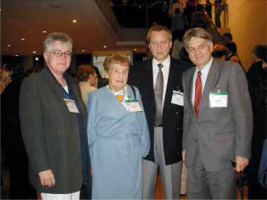
As a physician, academic teacher and scientist, Sławomir Majewski was a brilliant example of professionalism, and as a private person he was a cheerful open-minded character with a sense of humour, who did not create distance, who was collegial and family-oriented. It was a great privilege to have had the opportunity to work with him.









